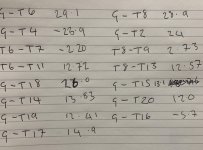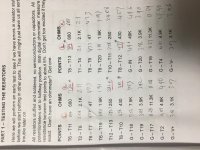Try adjusting P3 to lower T6-T7 and P4 to lower T8-T9 to the target 1.5V.
Can you get G-T18 significantly lower?
Can you get G-T18 significantly lower?
Can you try continue adjusting P4 to lower the G-T18 offset? See if you can get
it to less than 200mV.
Before you get all far, don't forget to adjust P1 and P2 so that
the T16 and T17 voltages are high enough to ensure the Vfets
have low bias when you install them.
( See top of page 8 of http://www.firstwatt.com/pdf/art_diy_sony_vfet.pdf )
it to less than 200mV.
Before you get all far, don't forget to adjust P1 and P2 so that
the T16 and T17 voltages are high enough to ensure the Vfets
have low bias when you install them.
( See top of page 8 of http://www.firstwatt.com/pdf/art_diy_sony_vfet.pdf )
Last edited:
I keep bringing it down. 0.6v so far.
The pot is so sensitive. A small movement means a large sudden change then it takes a whilst to settle down.
The pot is so sensitive. A small movement means a large sudden change then it takes a whilst to settle down.
Think I’m there.
1.5 across T6-T7 and T8-T9. T18 hovering around 200mv
I can move onto the next step now.
Andrew
1.5 across T6-T7 and T8-T9. T18 hovering around 200mv
I can move onto the next step now.
Andrew
Sounds good. 🙂
Assuming you've done the P1/P2 adjustments for T16 and T17, you
should be ready to install the vfets and bias up the output stage.
(Part 4 of Papa's document)
Cheers,
Dennis
Assuming you've done the P1/P2 adjustments for T16 and T17, you
should be ready to install the vfets and bias up the output stage.
(Part 4 of Papa's document)
Cheers,
Dennis
I’ll test it again tomorrow and see how it measures.
If good I’ll move on.
Thank you Dennis.
Andrew
If good I’ll move on.
Thank you Dennis.
Andrew
R15 and R16
Papa has noties: with 24VDC:
22V = 2.5V * (R15+4750 ohms)/4750 ohms 22V *4750 ohms / 2.5V = R15 +4750 ohms 41800 ohms = R15 + 4750 ohms
R15 = 37050 ohms.
You would pick the closest 1% resistor, which would be 36K or 36.5K for R15 and R16.
So with 28 vdc we have R15 or R16 is 44650 ohms. But in the schematic resistors 15 and 16 is 41.2 kohm
Which value is right for 28vdc voltage? 44.6 kohm or 41.2 kohm?
Thanks
Papa has noties: with 24VDC:
22V = 2.5V * (R15+4750 ohms)/4750 ohms 22V *4750 ohms / 2.5V = R15 +4750 ohms 41800 ohms = R15 + 4750 ohms
R15 = 37050 ohms.
You would pick the closest 1% resistor, which would be 36K or 36.5K for R15 and R16.
So with 28 vdc we have R15 or R16 is 44650 ohms. But in the schematic resistors 15 and 16 is 41.2 kohm
Which value is right for 28vdc voltage? 44.6 kohm or 41.2 kohm?
Thanks
41.2K will get you about 20V at T3, whereas 44.6K will get you about 22V.
It's more a question of the rail voltage you want to run the amp at. I suspect
both are fine, though the higher rail will run the vfets a bit hotter, but probably
a little bit more output.
41.2K should give you an amp with performance as documented.
Cheers,
Dennis
It's more a question of the rail voltage you want to run the amp at. I suspect
both are fine, though the higher rail will run the vfets a bit hotter, but probably
a little bit more output.
41.2K should give you an amp with performance as documented.
Cheers,
Dennis
Thanks Dennis!41.2K will get you about 20V at T3, whereas 44.6K will get you about 22V.
It's more a question of the rail voltage you want to run the amp at. I suspect
both are fine, though the higher rail will run the vfets a bit hotter, but probably
a little bit more output.
41.2K should give you an amp with performance as documented.
Cheers,
Dennis
I didn't read papa's words carefully: 'If your supply is lower than this, you should adjust R15 and R16 down so that
the R19 and R20 have at least 2 volts across them. '. So if we use a bigger power source like 29v or 30v, we can still use this resistor value (41.2Kohm) without changing it, right?
thanks
Yup. Even with higher initial voltage it will regulate down to roughly the same value.
Of course, your mosfets will run hotter.
Of course, your mosfets will run hotter.
Everything is pretty close, carry on. 🙂
Thank you very much, Sir.
I will go ahead, and may back with some other silly questions soon. 🙂
There are no silly or stupid questions. 😀 😀 😀
This is a hobby, we are all trying to learn here.
This is a hobby, we are all trying to learn here.
There are no silly or stupid questions. 😀 😀 😀
This is a hobby, we are all trying to learn here.
Thanks for your nice encouragement, Sir.
By the way, do you have any information of reliable sources k82j28 at this moment? All I could do now is pulling the k60j18 from my working Sony TA-4650, with not much hope of success. Understood that k82j28 are truly unobtainable, just a trying in asking..
- Home
- Amplifiers
- Pass Labs
- Sony vFET Illustrated build guide

